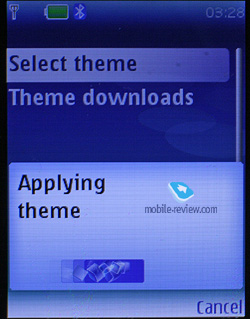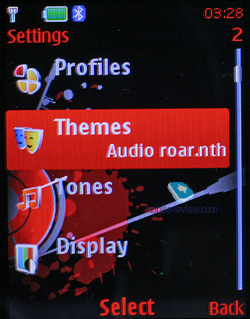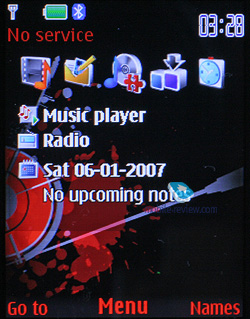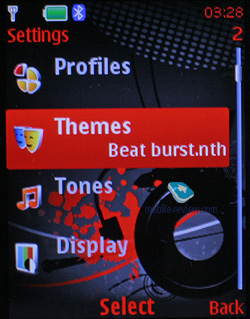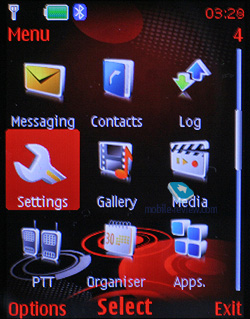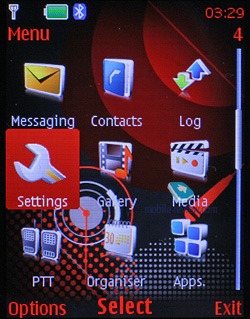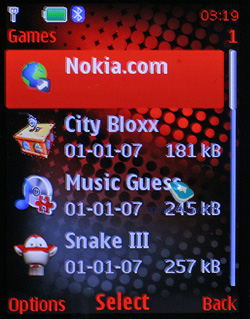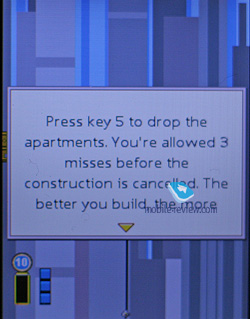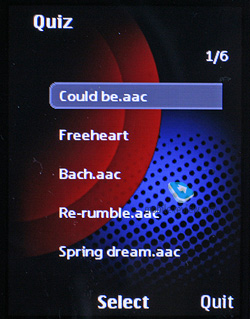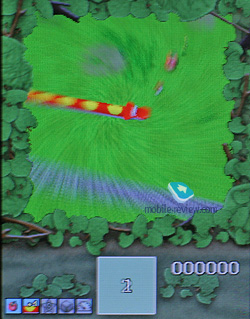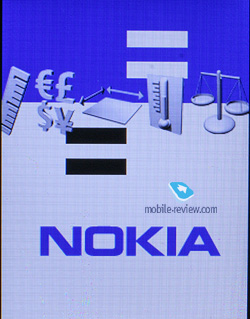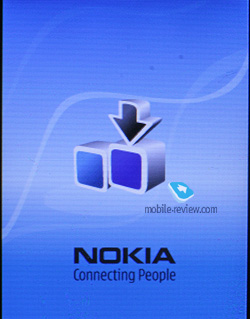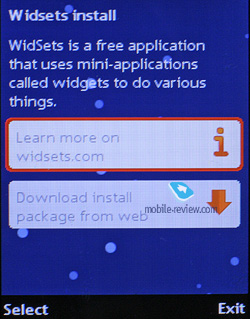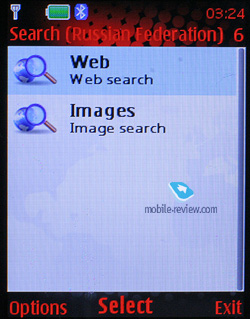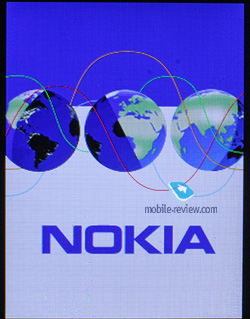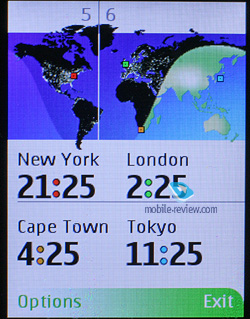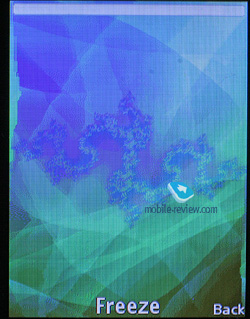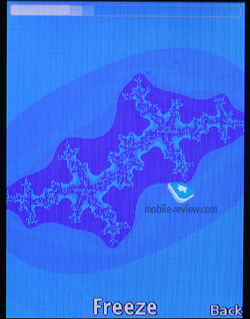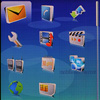|
|
Review of GSM-handset Nokia 5310 XpressMusic
Live photos of the Nokia 5310
Table of contents:
- Positioning
- Design, size, controls
- Display
- Keypad
- Battery
- Memory, memory cards
- Performance
- USB, Bluetooth
- Camera
- Themes, applications, games
- Music department
- Accessories for Nokia 5310
- Competition
- Impressions
Sales package
- Nokia 5310 XpressMusic
- Battery (BL-4CT, 860 mAh)
- Charger (AC-3)
- User Guide
- Wired stereo-headset (HS-45 with AD57)
- microUSB data cable (CA-101)
- microSD memory card (2Gb, varies by region)
- Software CD
- Nokia Music Store flyer
Positioning
The rapid development of the XpressMusic line-up required the maker to come up with a variety of solutions, including those running the S40 platform. Their edges over S60-powered solutions are slender size and better battery life, while sound quality is something that depends on dedicated chips and software abilities, having nothing to do with a product’s platform.
Along with its slim offerings, like the Nokia 6500 Classic, the maker comes up with a music-minded edition of this device and positions it as a decent solution for the youth. The reason being that their affinity functionality-wise could well make them to go up against one another, which wasn’t exactly the thing the company wanted. While the Nokia 5310 comes installed with a dedicated sound processor, its design has also undergone some changes, so now doesn’t seem to be no-nonsense all around. Given the difference in price of 150-170 Euro, these two phones can’t be really compared – their price tags are in two completely different weight categories, so to speak.
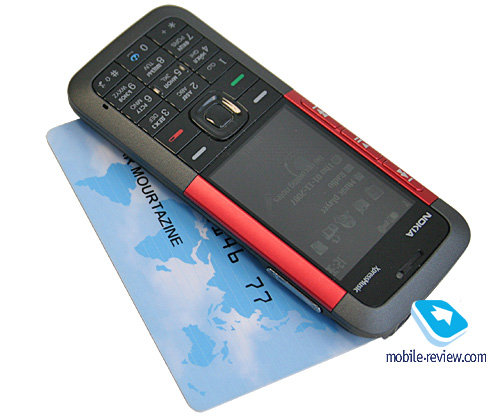
The company has presented the Nokia 5310 in a way that it seems to be opening the XpressMusic range, even though we all know the Nokia 5700 is also around. In other words, first goes a very conventional candy-bar type form-factor, then the Nokia 5610’s slider design and the Nokia 5710 rounds out the line-up. And in fact this is the first time when Nokia has managed to shape up a complete range of music-heavy handsets, where everyone can find a device to his/her own liking. The only reason the Nokia 5710’s debut got delayed is that they needed to sell off the Nokia 5700 supply, since these two share the form-factor, yet are set apart by a number of aspects like the senior model’s 3,2 Mpix camera unit.
While all three offerings will be presenting their users with pretty much identical sonic experience, they will be different in terms of functionality and sales package. Take a look at the table below to figure out the foremost differences between the models and the logic driving the XpressMusic range. One thing I have to note is that the Nokia 5710 hasn’t been officially announced as yet, and all its specifications below are subject to change, even though they are very unlikely to alter.
|
Nokia 5310 |
Nokia 5610 |
Nokia 5710 |
Music playback time (official) |
20 |
22 |
23 |
Hardware music controls |
Yes |
Yes, plus the slider |
Yes, swiveling base |
Bundled earphones |
HS-45 |
HS-45 |
HS-44 |
Bundled remote control |
No, only an extension cord with one button |
Yes |
Yes |
Platform |
S40 5th edition |
S40 5th edition |
S60 3rd Edition, FP1 |
Display |
2 inches, QVGA |
2.2 inches, QVGA |
2.2 inches, QVGA |
Bundled memory card |
2 Gb |
512 Mb or 1 Gb |
1 Gb |
Stereo-speakers |
Yes |
No |
Yes |
Price |
225 Euro |
300 Euro |
370 Euro |
The concept behind the range seems to be consistent – all three solutions are pretty much equal sound-wise, yet differ in terms of functionality. But the first thing you come across here is that two junior models come with somewhat mediocre headphones – the HS-45, which are bound to be thrown away in favor of a pair of your own earphones in order to truly enjoy the quality delivered by the XpressMusic. The same holds true for the Nokia N81 too, so all there handsets listed above, expect for the Nokia 5710, will sound pretty much in the same vein provided that you have default earphones plugged in. The Nokia N81 could well be a music-centric solution, if it weren’t for the 5710. With their price tags being equal at 360-370 Euro, the Nokia 5710 ships with a 3,2 Mpix auto focus enabled camera, which makes it a more interesting choice. But just like it is with the Nokia 5310, its snazzy design should put most ‘conservators’ off. In my opinion, it would be interesting to find out how certain touches and accents in design can narrow down, or beef up target audiences. For example, in this very case we are dealing with the Nokia 5710, the Nokia N81 and another Nokia-branded smartphone that is yet-to-be-debuted, which are not very different as far as their price tags are concerned. But some trimmings in functionality here and there and somewhat different designs turn these models into peacefully coexisting offerings, rather than a bunch of siblings trying to cut each other’s throat on the market.
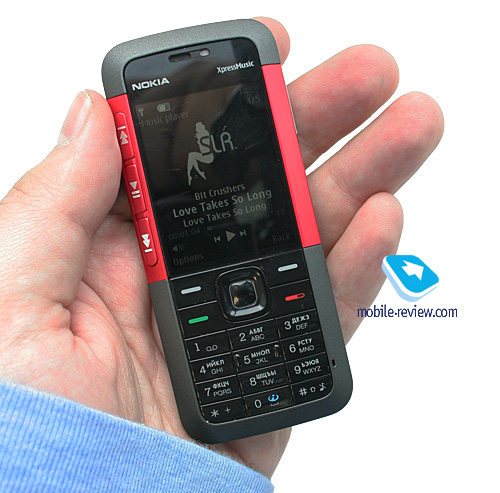
By outlining the price-bracket for its music-inclined solutions, the company has in fact lifted the veil of secrecy over the first six months of 2008. Unlike the Walkman range, which is getting beefed up with entry-level offerings, Nokia doesn’t seem to bank on them. The prime aspect for this maker is sound quality, which his efforts are now centered on. It turns out that with price cuts taking place quarterly, the junior model in the XpressMusic line will retail for 180-185 Euro upon withdrawal from the market, which constitutes the bottom-line price for Nokia’s music playing devices.
And there is no upper limit for this segment. Despite the fact that the backbone of the XpressMusic comprises three abovementioned models, a ton of NSeries solution will be coming in with the same background. Take the N81, for example, where the manufacturer doesn’t really highlight its music department, packs it with pretty mediocre headphones and generally tries to sell its other merits. Its music prowess acts as an important extra feature, yet it is not this smartphone’s primary selling point. It is a quite shrewd approach leaving some space for maneuvering.
A breakdown of the XpressMusic price-bracket shows that the 70-Euro step between their price tags is too much – when it comes down to 50 Euro in the future and provided that the company will keep the range in the same price-bracket, they will be able to cram not 3, but 4 models into the line-up. As I see it, they would do no wrong by launching an NSeries-esque flagship in music jam-packed with accessories in the box for about 350-380 Euro. It won’t look like the Nokia 5700/5710 for sure, due to their quirky form-factor. But let’s not anticipate things, since it is still one long year separating us from autumn-winter of 2008.
Nokia has been into accessories for the current XpressMusic range – some of them will get a rundown in this write-up. Since the times of the Nokia 5200/5300, XpressMusic has been employing blue and red as its trademark colors (including some hues) – this very handset is no exception.
Back to the table of contents >>>
Design, size, controls
The phone measures up at 103,8x44,7x9,9 mm and tips out scales at 71 grams, meaning that it boasts a really skinny profile, which is what it impresses you with, pretty much like the Sony Ericsson W880i does. It will keep low profile anywhere you throw in – in a shirt’s pocket or jeans, so you can carry it as you please.
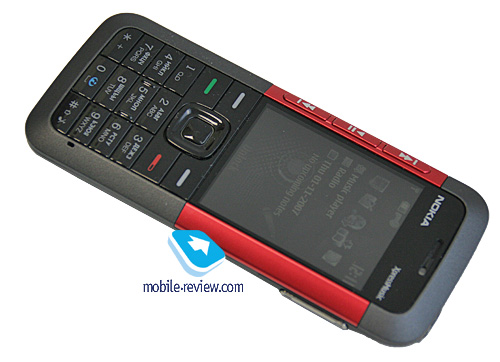


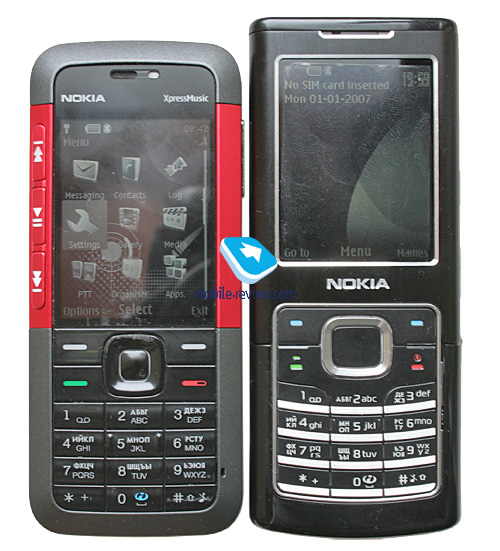
There are two color options available for the Nokia 5310, which are the trademark colors of Nokia’s music-savvy range – blue and red. The color areas on the phone include the zone framing the display and metal insets. Flipping over to the phone’s rear, you will find the maker’s name clad in one of these colors. The rest of the handset’s casing is made of matte dark-grey plastic.
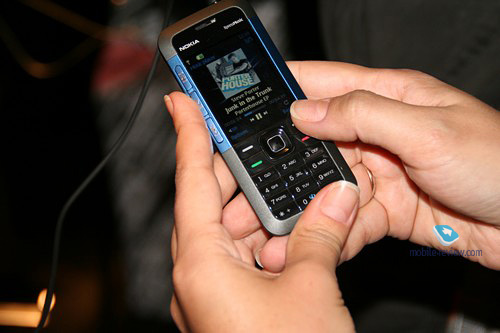
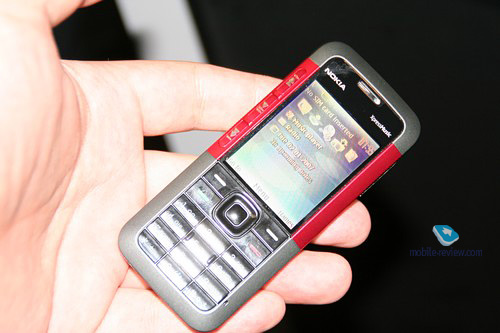
The Nokia 5310’s plastic quality is pretty admirable, since it appears to be scratch-resistant. The battery cover is coated in a pattern of dots, which, in their turn, are exposed to wear and tear, so after some time, your phone’s rear will look pretty worn out. Curiously, while the casing itself remains in pristine condition, the dots on the underside are not as durable, so all effaced somewhat break the pattern.
The left-hand spine houses the charger slot (2 mm socket), looking at the top edge you will discover the 5310’s power button and the 3,5 mm audio jack alongside the microUSB socket, covered with a plastic flap. The volume rocket sits on the right-hand flank. Interestingly, a dedicated camera button is nowhere to be seen. By the way, the lens of the phone’s 2 Mpix camera is mounted on the rear side.

No lanyard eyelet is available on the 5310’s casing.
The ambient light sensor, adjusting the display’s and keypad’s backlighting is placed not where we would expect to see it – it sits on the right of the earpiece.

Back to the table of contents >>>
Display
Whereas the Nokia 6500’s display has no protective layer on it, the Nokia 5310 enjoys one. Thanks to its mirror-like edge, the 6500 Classic’s screen seems somewhat larger, but size-wise, it is no different from the 5310. What is more, in terms of specs, these two displays are twins, which brings forth a question why would they need to dump a protective layer in the senior model.

The 5310’s display sports 2-inch diagonal and a resolution of 240x320 pixels (31x41 mm), showing up to 16 million colors. All this results in a bright and vibrant picture. This model is actually notable for its pretty much decent display, standing in one line with today’s offerings from Sony Ericsson, like the Sony Ericsson W580i.
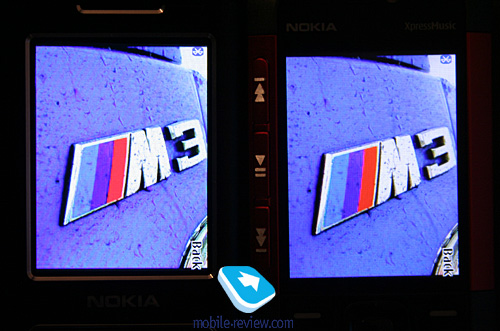

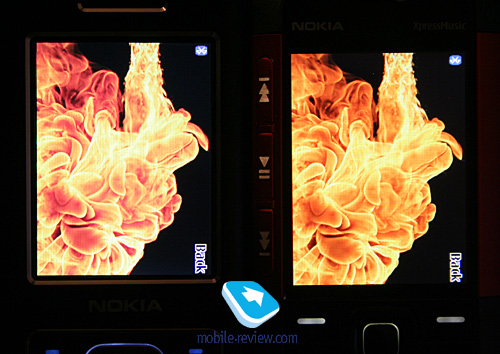
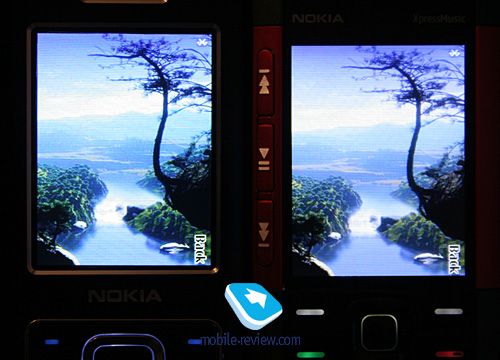

The display remains readable in the sun (TFT), which is mainly due to the tinted protective layer. However, even this screen starts glaring heavy on some occasions, so you will need to find the right angle. Regrettably, given the display’s relatively tiny diagonal, it is not very convenient to use outdoors, which is also true of other phones with 2-inch screens onboard.
The display accommodates up to 9 text and 3 services lines. The font size won’t give you any trouble, furthermore, you can manually adjust its size for some modes and applications.
Back to the table of contents >>>
Keypad
The numeric keypad is a cinch to use – all of its medium-sized buttons sit very close to each other and more importantly, offer the use a pretty good travel distance and almost misclick-free performance. Even the smallish navigation key is fairly easy to handle. Comparing the 5310’s keypad with the Nokia 6500 Classic, the former comes out a clear winner. The keypad’s white and relatively soft backlighting kicks in automatically.
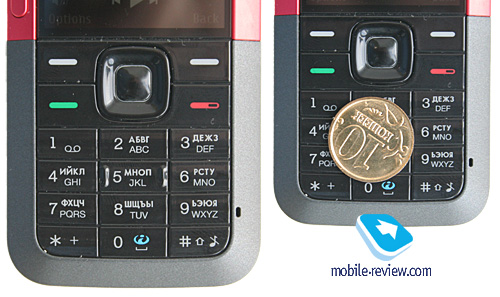
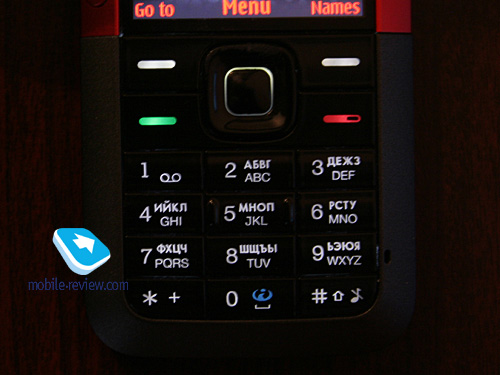
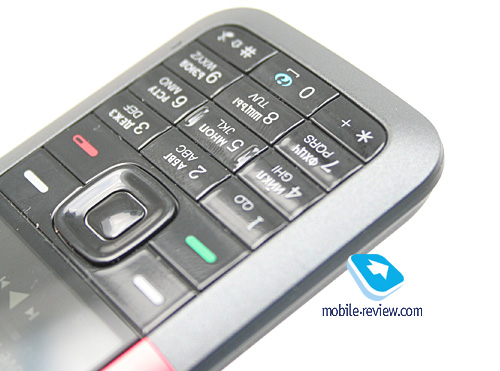
Back to the table of contents >>>
Battery
The handset comes with a new battery type – the BL-4C, which is a 860 mAh Li-Ion cell. As the maker claims, it is good for up to 5.4 hours of talk time and 300 hours of standby. In Moscow, our 5310 lasted around 3 days with 2 hours of music, 1,5 hours of calls and very few SMS. So most users may expect it to stay online about 2-3 days with their usage patterns. The longest music playback time we managed to squeeze out of it (native headphones, max volume settings was 18 hours 50 minutes (radio module enabled). It takes the 5310 1 hour and 40 minutes to charge from empty to full.
The battery is one of this model’s fortes, as it presents the user with battery time which is in line with many stand-alone solutions these days, and this definitely can’t be overlooked.
The handset employs a quirky SIM-card holder design, which users the battery’s contacts for locking your SIM card in the slot, so you won’t be able to pull it out on a working handset.


Back to the table of contents >>>
Memory, memory cards
The handset ships with around 28 Mb of storage that can be managed by the user. The microSD memory expansion slot is housed under the battery compartment cover, and on top of that, it allows you to swap cards on the fly. The maximum memory card size supported by the device is unlimited – we plugged in our 4 Gb unit and experience absolutely no problems with it.
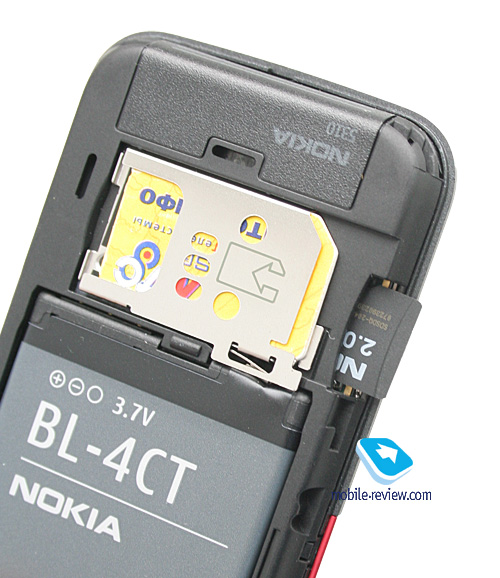
Performance
JAR-file size limit – 1 Mb, heap size – up to 2 Mb. The 5310 is no different from its platform’s average results performance wise.
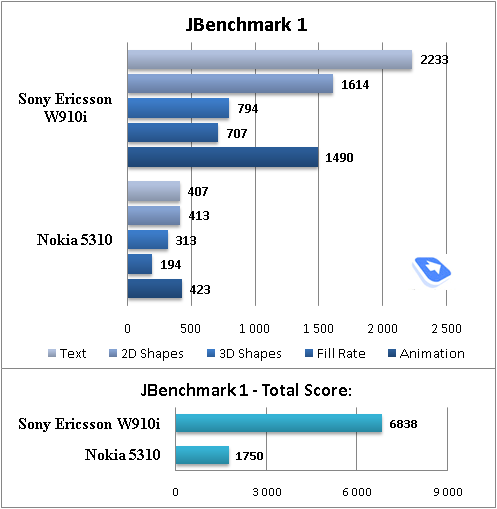
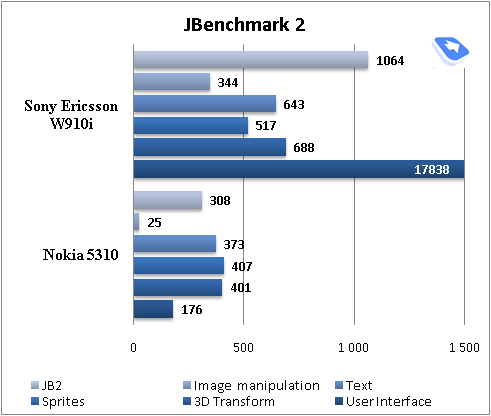
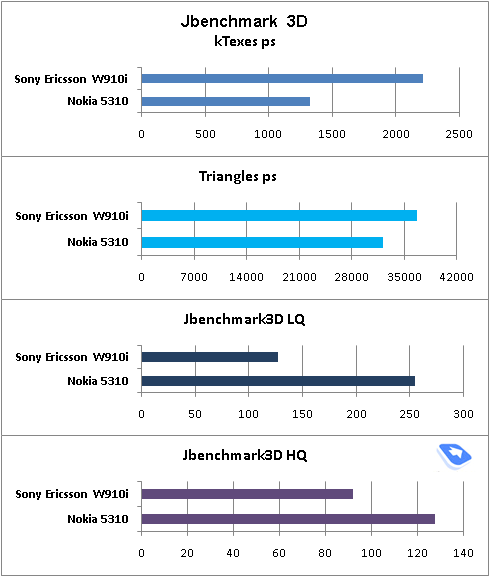
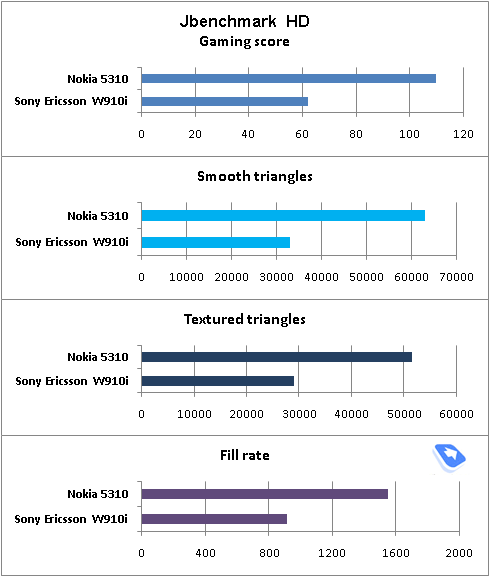
Back to the table of contents >>>
USB, Bluetooth
USB. The Nokia 5310 comes with the microUSB socket, housed on the top edge of the phone. This socket is used for plugging in a data cable (the phone starts charging up), headset or charger.
The vendor says that the handset supports USB 2.0, and it does indeed, in USB Mass Storage mode the connection via USB cable puts up medium data transfer speed which makes up about 500-600 Kb/s. This is slower than the Motorola RAZR2 V8, which also comes installed with microUSB-socket.
Upon successful connection you can pick one of the following modes: USB Mass Storage, PC Studio, or modem mode. There is no support for MTP mode, music tracks have to be moved onto the phone manually. The selection of folders, where you will be able to locate music tracks, is limited to a number of presets, no word on whether this restriction will remain in the 5310’s commercial version.
Bluetooth. The handset comes with EDR-enabled Bluetooth 2.0. The following profiles are supported:
- Dial-Up Networking Profile
- Generic Access Profile
- Generic Object Exchange Profile
- Object Push Profile
- Serial Port Profile
- Handsfree Profile
- Headset Profile
- Synchronization Profile
- Basic Image Profile
- File Transfer Profile
- HID (host) Profile
- Stereo Advanced Audio Distribution Profile
- Advanced Audio/Video Remote Conference Profile
The Bluetooth implementation is, as always though, nothing to complain about, we encountered no issues with handling this type of connections. The stereo-headset also works fine. Unlike the Nokia 6500 Classic, the 5310’s Bluetooth speed tops out at 78 Kb/s, whereas the Classic’s speed is around 1700180 Kb/s .
Back to the table of contents >>>
Camera
This handset has 2mpx camera (CMOS) which is not that much by today’s standards, but it is still pretty much sufficient for a mid-tier offering. Nokia has decided not to bet on the camera part, it is more of an optional feature here. This is why camera’s module picked for 5310 is one of the cheapest units out there, and provides average quality.
The following resolutions are supported:
- 1600x1200
- 1280õ1024
- 1280x960
- 800x600
- 640x480
- 320x240
- 160x120.
Two lower resolutions were added for creating photos that would fit as wallpapers for display. Three JPEG compression types are supported: basic, normal, high. Considering the fact that photos do not blow your imagination away, it is better to go for the top quality, it won’t get any worse after all.
The shutter sound can be disabled, also there is a 8x digital zoom, but there is no reason to use it. You can save photos in the internal memory or on the memory card.
Some effects can be applied to the already made photos, should they be used initially – it is up to you to decide. Such effects as False Colours, Greyscale, Sepia, Negative, Solarize are available.
For those who love to shoot a lot of photos at once, there is special mode for you – camera makes up to 3 shots at a time, all settings remain similar to those selected for the single shot mode, including the resolution. There is an auto-timer for self-shots.
 |
 |
| (+) maximize, 1200x1600, JPEG |
(+) maximize, 1200x1600, JPEG |
 |
 |
| (+) maximize, 1200x1600, JPEG |
(+) maximize, 1200x1600, JPEG |
 |
 |
| (+) maximize, 1200x1600, JPEG |
(+) maximize, 1200x1600, JPEG |
 |
 |
| (+) maximize, 1200x1600, JPEG |
(+) maximize, 1200x1600, JPEG |
 |
 |
| (+) maximize, 1200x1600, JPEG |
(+) maximize, 1200x1600, JPEG |
 |
 |
| (+) maximize, 1200x1600, JPEG |
(+) maximize, 1200x1600, JPEG |
 |
 |
| (+) maximize, 1200x1600, JPEG |
(+) maximize, 1200x1600, JPEG |
 |
 |
| (+) maximize, 1200x1600, JPEG |
(+) maximize, 1200x1600, JPEG |
 |
 |
| (+) maximize, 1200x1600, JPEG |
(+) maximize, 1200x1600, JPEG |
 |
 |
| (+) maximize, 1200x1600, JPEG |
(+) maximize, 1200x1600, JPEG |
Video. The handset allows recording video in 3GP format, available resolution – 128x96 pixels, or 176x144 pixels. There are three recording quality settings available. You can limit a recording’s length, but it also can be unlimited, so you will keep recording until the memory runs out (memory card or internal memory). Effects can be applied for video just as they can be applied for photos, they are all the same.
Back to the table of contents >>>
Themes, applications, games
The handset boasts a number of themes that substantially vary its looks, seem to be well-elaborated, meshing with the handset’s overall image.
The handset comes preinstalled with an array of games – City Bloxx, Snake III, Music Guess.
The Applications section includes such standard functions like World Time, Converter, Widgets installer, and Nokia’s catalogue for uploading new apps. The 5310 also packs version 2 of Yahoo! Go.
Also under the phone’s hood is Nokia Search for, well, searching data, images in the web – unique search engine for every region (can be altered in the settings).
Opera Mini needs no introduction, it comes preinstalled with most S40-powered models.
Nokia Sensor will appeal to the youth.
A new utility spotted on the 5310 is Wallpaper Creator.
Just as we expected it from the Nokia 5310 all its themes have much to do with its musical talents.
Back to the table of contents >>>
Music department
The 5310 is no different from other models running the S40 5th edition – its player matches them spec-wise. And we are not going to examine it all over again in this write-up, for you can always learn more about it in our review of this platform. The Nokia 5310 comes preinstalled with a couple of unique themes color-keyed to every trim of the device (the red version of the handset has red skins for the music player, plus the default theme, blue)


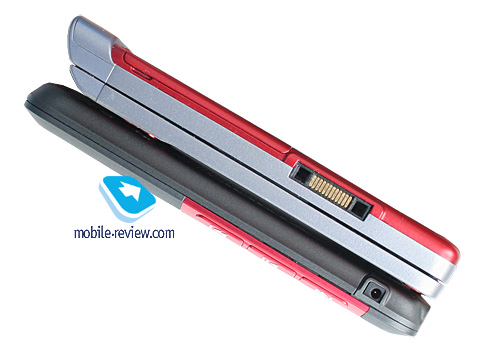
The side-mounted keys mean that you are always a click away from launching the music player and jumping back and forth between your tracks. Probably, this is one of the reasons why they omitted a remote control from the 5310’s sales package.

The sonic experience delivered by the phone is pretty good, thanks to its built-in AIC33 chip, the one found in other latest and greatest XpressMusic offerings or the Nokia 5700. The volume you get in headphones is also pretty much sufficient, and generally the 5310 is a potent music-minded device, although, from my subjective point of view, its sound could be a tad deeper at times. While it can’t stand up to the Nokia N91 or the Samsung i450, the 5310’s sound quality is okay, being in line with Samsug’s Beatz Range and ahead of Sony Ericsson’s Walkman phones (not for all genres, but it does have an edge there).
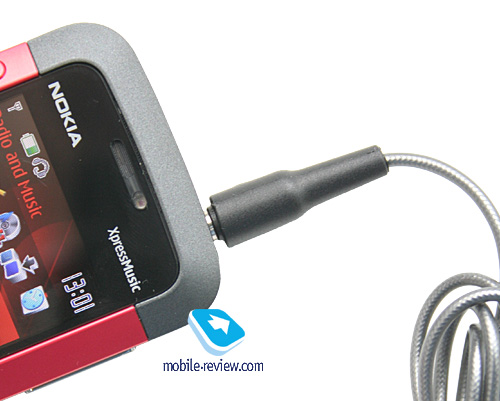
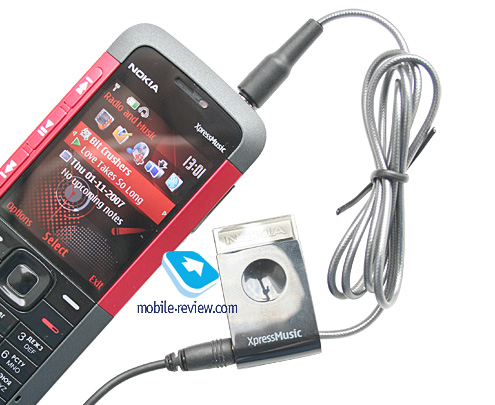
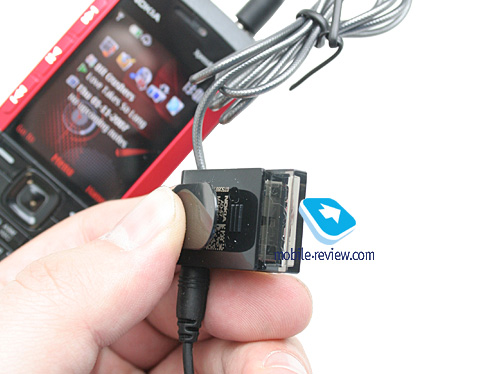
Here is what our RMAA tests told us about the Nokia 5310:
General performance
Frequency response (from 40 Hz to 15 kHz), dB: |
+0.17, -1.48 |
Average |
Noise level, dB (A): |
-87.8 |
Good |
Dynamic range, dB (A): |
87.0 |
Good |
THD, %: |
0.013 |
Good |
IMD, %: |
0.786 |
Bad |
Stereo crosstalk, dB: |
-73.0 |
Good |
Intermodulation at 10 kHz, %: |
0.155 |
Average |
General performance: Average
Frequency response

Noise level

Alexander Dembovsky’s take on the Nokia 5310:
The Nokia 5310’s 3,5 mm audio jack adds a whole lot to its musical merits, especially given its dedicated sound processor. All adapters usually bring along a ton of noises, just like in the case with the Samsung i450. The Nokia 5310 offers a decent output volume and will easily handle any headphones, saving for the over band type. The thing I want to note here is that when we put handsets through their paces with Rightmark Audio Analyzer, we only assess “pure” signal at highest volume settings and no equalizers or whatever enabled. The Frequency response of the Nokia 5310 is pretty decent – it won’t pale in comparison with a stand-alone audio player from a top 10 maker. Our only gripe with the 5310 is its shrunk level of highs, which leaves us with the range of around 8-16 kHz. Although, all “natural” sound buffs will be happy with this, since the 5310 softens those usually sharp highs of mid- and low-bitrate tracks. Nonetheless, you can always tune the phone’s sound to your liking via the bunch of equalizers available with it.
The 5310’s music playback time is around 19 hours, which is not bad for such a petite device. For the speakerphone mode, as the maker stresses, the handset employs stereo speakers. And if you take a look at the rear, you will see three slots, however the one on the left is fake, since it actually transfers the sound for the speaker embedded in the middle. As you might have already guess, with its speakers sitting this close to each other and being so weak, the 5310 has no stereo effect whatsoever – all these rants have nothing to do with its performance, pure marketing tricks.
Judged on its musical merits, the Nokia 5310 is an interesting solution – pretty decent sound, player skins and very functional interface. All this puts it in one league with other contemporary devices, as it doesn’t have any particularly weak spots.
Back to the table of contents >>>
Accessories for Nokia 5310
The company is also trying to gear up its XpressMusic devices with unique accessories, through partners as well. One of these accessories if the JBL On Call 5310 music-minded docking station, where you can put the device in and get it connected with the station’s charger port and audio plug. While it houses the socket for linking it up with a normal charger, you can go for batteries as well (in this case, you phone won’t get recharged while inside).

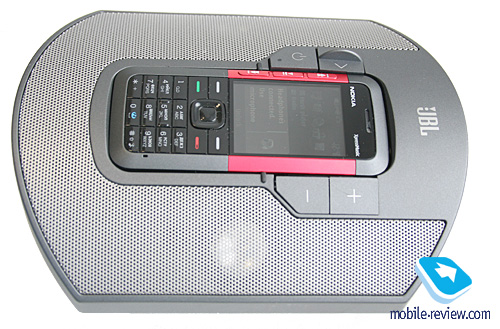

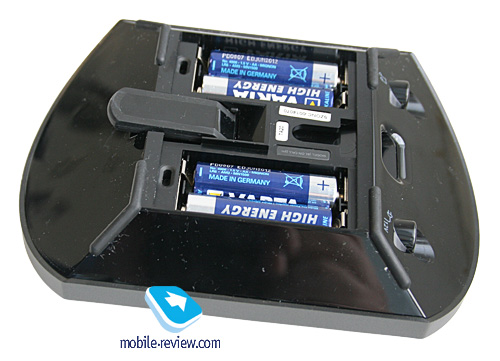
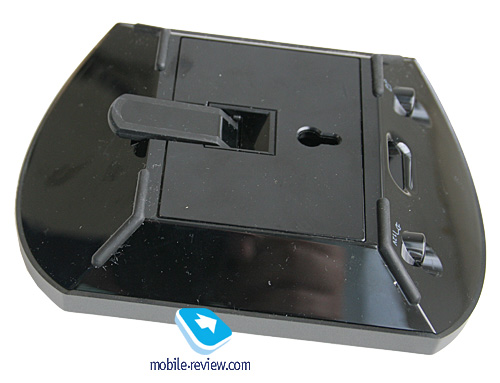
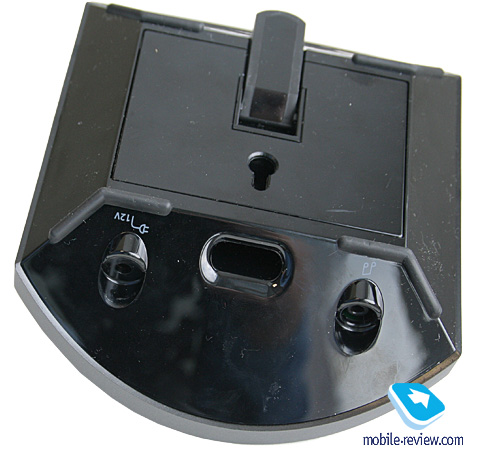
The JBL’s speakers are loud and clear, being especially good at reproducing bass. All in all, a docking station like this transforms the Nokia 5310 into an epitome of a small stereo, even though it doesn't have the makings of a real replacement for your full-sized home stereo. Some may well find this accessory interesting enough, though.
The set of portable speakers (MD-6) is another accessory available for the Nokia 5310. It runs on four AAA batteries and provides quite sufficient volume, yet with average sound quality, which has nothing to shout about. The speakers connect to the phone via the standard audio jack.
These portable speakers might interest those fond of picnics or outdoor parties. The MD-6 has a rated battery life of 27 hours (off one set of batteries, which is pretty good).
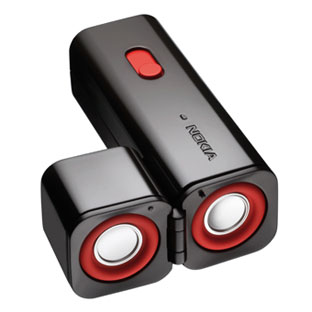
Overall, the Nokia 5310 still doesn’t have an army of accessories backing it up, but we will see more for the models to come. Nokia seems to have gotten serious about what its users can grab in addition to their phones.
Back to the table of contents >>>
Competition
There is only one direct competitor to this model on the market, and it is the Sony Ericsson W880i. While the Sony Ericsson’s offspring is made of better materials, the 5310 trumps it with its standard audio jack, more ergonomically-friendly keypad and FM-radio. In terms of camera, standby time and size, these two are no different at all. The thing is, the W880i focuses more on fashion and style, whereas the Nokia 5310 is more of a youth-aimed device, which sets them apart, but the youth will still see two real ways to go in them.
If the 5310’s design doesn’t bother you, then it is a better solution from a functionality standpoint. Early in 2008 with the arrival of the Sony Ericsson W890i, we will see an interesting collision, however – the W880i will get cheaper than the Nokia 5310, which is what we expect from a less functional offering, whereas the W890i will have a price tag as hefty as the Nokia 6500 Classic.
The table below compares the spec sheets of the abovementioned models:
|
Nokia 6500 classic |
Sony Ericsson W880i |
Nokia 5310 |
Size, weight (mm, grams) |
109.8x45x9.5, 94 |
103x47x9.4, 73 |
103.8x44.7x9.9, 71 |
Display |
QVGA, 2 inches, 16 mln. colors, TFT |
QVGA, 1.8 inches, TFT, 262000 colors |
QVGA, 2 inches, 16 mln. colors, TFT |
Battery |
Li-Pol, 830 mAh |
Li-Pol, 950 mAh |
Li-Ion, 860 mAh |
Memory |
1 Gb, built-in |
40, MS M2 memory card (ships with 1Gb in the box) |
20 Mb of built-in storage, microSD slot |
OS version |
S40 5th Edition |
SE A100 |
S40 5th Edition |
UMTS |
Yes |
Yes |
No |
Camera |
2 Mpix, CMOS. 176x144-pixel video |
2 Mpix, CMOS. 176x144-pixel video |
2 Mpix, CMOS. 176x144-pixel video |
Connectivity |
microUSB for all purposes |
Fast Port, 3.5 mm jack on the headset |
microUSB, 3.5 mm |
Bluetooth |
2.0 + EDR, A2DP support |
2.0 + EDR, A2DP support |
2.0 + EDR, A2DP support |
Player |
Enhanced |
Walkman 2.0 |
Enhanced |
Materials used |
Anodized aluminum, plastic |
Plastic, metal slabs |
Plastic |
FM-radio |
No |
No |
Yes |
Price |
400 Euro |
340 Euro |
230 Euro |
Another competitor to the 5310 might come in the form of the Nokia 6300, which is an indirect rival, though. People who will consider it will be after a slender handset with a reasonable price tag, while its functionality won’t make any difference to them. For these consumers the Nokia 5310 won’t be an adequate way to go in view of its price.
Back to the table of contents >>>
Impressions
The volume presented by 64-chord ring tones is average, overall the 5310 is not the loudest device around, so we experienced some difficulties with hearing it in the street, and it lacked volume indoors as well. Actually, this is our major gripe with the handset. In terms of reception quality, the phone is flawless. The vibro alert is middling strength-wise, but you will feel the phone’s vibration while it is in your pocket.
Given its current price tag of 230 Euro (in Europe), this phone appears to be a pretty good way to go if you are looking for an entry-level music playing solution – it is quite petty and sports all the goodies of the S40 5th edition under the hood. The youth won’t find a better offering if they are after a straightforward and functional phone, when getting used to a smartphone is not an option.
If you are a music buff, you will be better off with the senior models, even though you won't notice much of a difference between them sound-wise with a pair of custom earphones plugged in. They will come jam-packed with accessories and different form-factors.
On balance, the 5310 is the handset opening Nokia’s music range. It is a potent device, not without some flaws, yet boasting an array of advantages as well. It probably won’t be a best seller, but will generate some solid sales.
Related links
Back to the table of contents >>>
Eldar Murtazin (eldar@mobile-review.com)
Translated by Oleg Kononosov (oleg.kononosov@mobile-review.com)
Published — 03 December 2007
Have something to add?! Write us... eldar@mobile-review.com
|
News:
[ 31-07 16:21 ]Sir Jony Ive: Apple Isn't In It For The Money
[ 31-07 13:34 ]Video: Nokia Designer Interviews
[ 31-07 13:10 ]RIM To Layoff 3,000 More Employees
[ 30-07 20:59 ]Video: iPhone 5 Housing Shown Off
[ 30-07 19:12 ]Android Fortunes Decline In U.S.
[ 25-07 16:18 ]Why Apple Is Suing Samsung?
[ 25-07 15:53 ]A Few Choice Quotes About Apple ... By Samsung
[ 23-07 20:25 ]Russian iOS Hacker Calls It A Day
[ 23-07 17:40 ]Video: It's Still Not Out, But Galaxy Note 10.1 Gets An Ad
[ 19-07 19:10 ]Another Loss For Nokia: $1 Billion Down In Q2
[ 19-07 17:22 ]British Judge Orders Apple To Run Ads Saying Samsung Did Not Copy Them
[ 19-07 16:57 ]iPhone 5 To Feature Nano-SIM Cards
[ 18-07 14:20 ]What The iPad Could Have Looked Like ...
[ 18-07 13:25 ]App Store Hack Is Still Going Strong Despite Apple's Best Efforts
[ 13-07 12:34 ]Infographic: The (Hypothetical) Sale Of RIM
[ 13-07 11:10 ]Video: iPhone Hacker Makes In-App Purchases Free
[ 12-07 19:50 ]iPhone 5 Images Leak Again
[ 12-07 17:51 ]Android Takes 50%+ Of U.S. And Europe
[ 11-07 16:02 ]Apple Involved In 60% Of Patent Suits
[ 11-07 13:14 ]Video: Kindle Fire Gets A Jelly Bean
Subscribe
|


















































